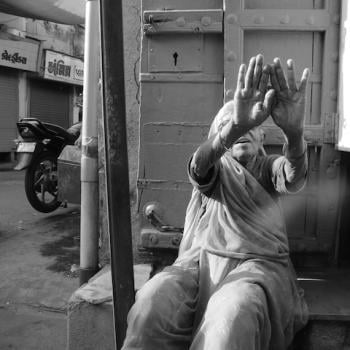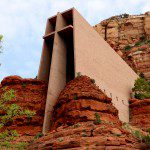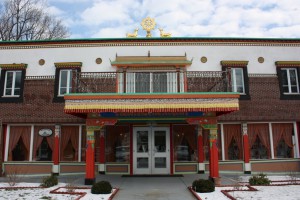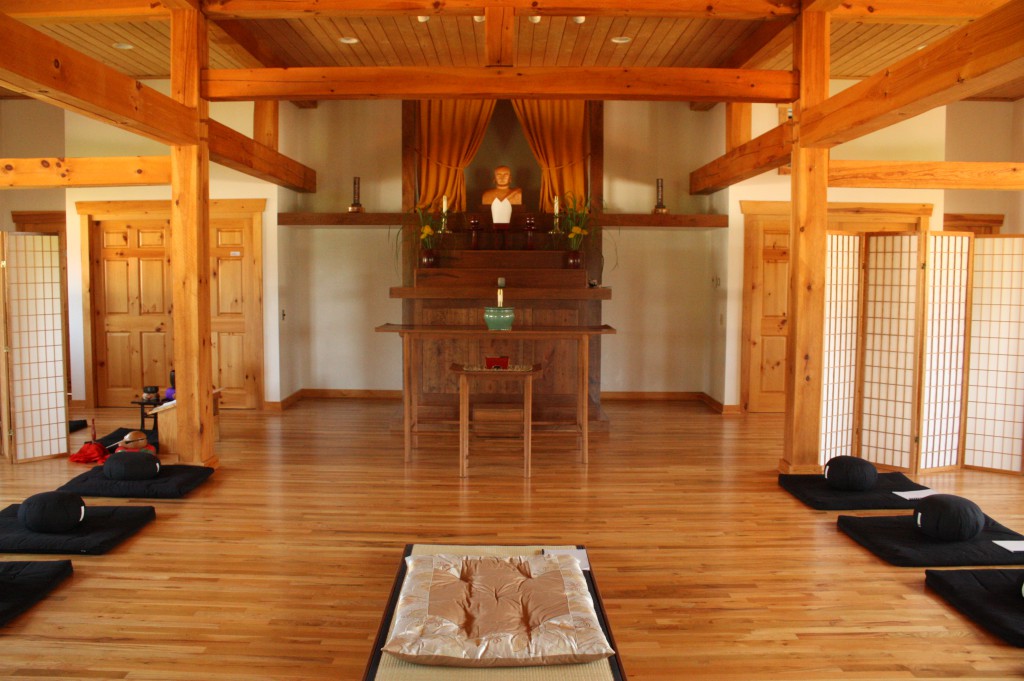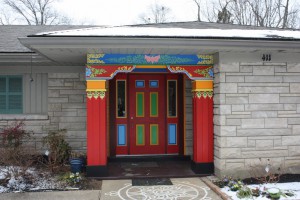
When you arrive at the Drepung Gomang Institute (DGI) in Louisville, it looks a lot like any suburban house–until you approach this door. Its brilliant colors and designs are an indication that the home isn’t your ordinary dwelling.
Though DGI was established relatively recently in 2001, it has a much older lineage. It is the sister organization to one of the oldest and most important Tibetan Buddhist monasteries, the Drepung Gomang Monastery, which was founded in 1416 near Lhasa. Before the Chinese invasion it was home to 10,000 monks (the large number is a reflection of the fact that an amazing 20 percent of the population of old Tibet lived in monasteries). About 100 monks managed to escape with the Dalai Lama when he fled Tibet in 1959. In 1969 Drepung Gomang was re-established as a monastery-in-exile in southern India and today is home to more than 2,000 monks, many of whom have escaped from Tibet and now call India home. DGI is its U.S. counterpart, so when you enter that door, you’re actually encountering a tradition far older and grander than you realize.
This phenomenon of religion-in-exile is curious, I think, and the DGI illustrates many of its paradoxes. What has happened in Tibet is a tragedy of global significance. And yet without the Chinese invasion, Tibetan Buddhism would have remained isolated and inaccessible to the larger world. Because of the terrible persecution this tradition suffers, its seeds have been scattered around the world, taking root in seemingly unlikely places (Exhibit A: a suburban neighborhood in Louisville, Kentucky). With good reason, some have compared the Tibetan Diaspora to the Jewish Diaspora, both of which required a dramatic re-orientation of religious and cultural foundations. As a result, these traditions have spread far beyond the borders of their original homelands.
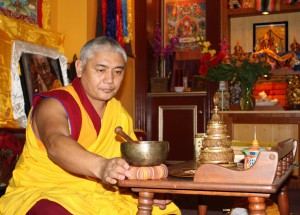
When I visited the center, I was honored to meet its resident director, Geshe Kalsang Rapgyal, a Tibetan-born monk and scholar. The title of geshe is given to a highly esteemed teacher who has completed decades of rigorous academic study. Rapgyal was appointed to lead DGI by the Dalai Lama and he is the impetus behind His Holiness’s visit to Louisville May 19-21. But despite his prodigious learning he is a warm and down-to-earth man. He’s working hard right now to improve his English (one would think this would be a less formidable challenge than mastering the philosophical intricacies of Tibetan Buddhism). I can also personally attest to the fact that he makes delicious momos (traditional Tibetan steamed dumplings).
DGI includes the Tashi Gomang Dharma Center, which holds weekly teachings, meditation sessions, special ceremonies and events. If you’re a first-time visitor, don’t be shy. Just remove your shoes before entering the shrine room and be respectful during your stay. DGI welcomes people of all faiths and is eager to help visitors learn about Tibetan Buddhism. Most of the members of this community are American-born, not Tibetan, so they know what it means to be a newbie.
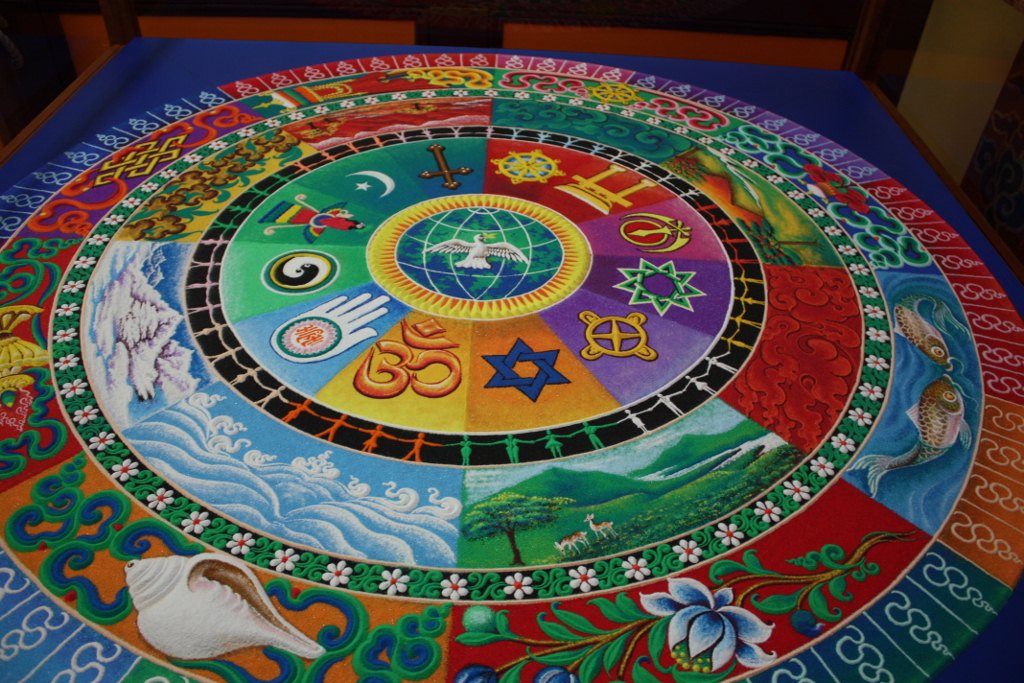
A distinctive practice of Tibetan Buddhism is visible right inside the door to the shrine room. Beneath protective glass is an exquisite mandala made from sand. Monks labor for weeks on the design of these fragile works of art, carefully applying the sand granules with small funnels. Once the exquisite design is completed, the mandala is ceremoniously destroyed. The sand is put into a container and then released into a flowing body of water, so that the blessings it contains can spread throughout the world. The process is a vivid enactment of the transitory nature of existence, a central teaching of Buddhism.
The mandala at DGI contains sacred symbols of many faiths, an indication of the high value the institute places on interfaith dialogue. While it is currently on display, bringing blessings to those who view it, eventually it will be destroyed and returned to the earth, and another will take its place. So the wheel of existence turns, creation followed by death followed by creation.
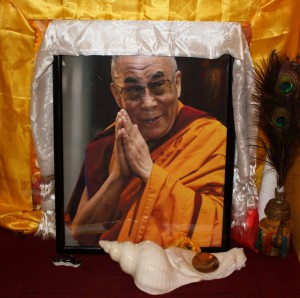
DGI’s mission is to give people a chance to study and practice Tibetan Buddhism traditions and philosophy, to help preserve Tibetan culture, and to foster interfaith dialogue and teachings on compassion and peace-making. It also sponsors tours of monks from its sister monastery in India, who travel around the U.S. to raise awareness of the on-going persecutions in Tibet and to raise funds for the monastery’s food and medical needs.
It is an amazing world, is it not? A tradition that has its roots high in the Himalayas now flourishes in places just down the street from us. I’m happy to know that when the Dalai Lama comes to Louisville in May, he has a home-away-from-home waiting eagerly for his arrival.
For details on tickets for the Dalai Lama’s visit to Louisville May 19 to 21, see www.DalaiLamaLouisville.org. His visit will be preceded on May 14-19 by the Festival of Faiths, a Louisville celebration of religious diversity now in its 18th year. The theme of “Sacred Silence: Pathway to Compassion” will be explored in addresses by internationally known speakers, interfaith prayer and meditation services, panel discussions, music, art and films. See www.festivaloffaiths.org for more information.



